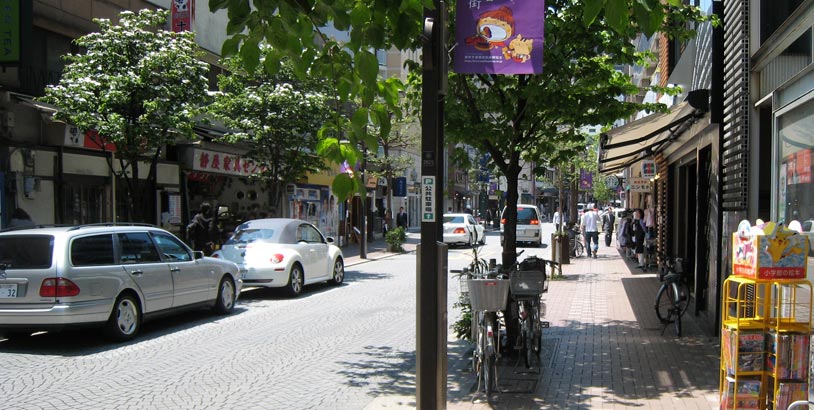- Tokyo top
- Central
- My Akihabara
- Yushima Seido
- Kanda-Jinbocho
- Edojo - Shoguns’ Palace
- Hibiya Park
- Ginza - clues to its past
- Zojoji - Shoguns’ graveyard
- Tokyo Tower
- Minato Shichi-fukujin
- Maruyama Kofun
- Always Sanchome-no-yuhi
- North & East
- Shibamata - Tora-san
- Tokyo Sky Tree
- Asakusa
- Kappa-bashi
- Monzen-Nakacho
- Yanaka after 12 years
- Rikugien
- Koishikawa Bot. Gardens
- Zoshigaya Cemetery
- West
- Azabu Jūban
- Meiji Jingu
- Shinjuku Golden Gai
- Nakano Broadway
- Shibuya - Shibuchika
- South
- Ikegami Honmon-ji
- Western Suburb
- Koenji - Awa-odori Festival
- Koenji - Look Street
- Hamadayama in 2011
- Hamadayama
- Narita - history of a district
- Kamakura-kaido - old road
- Seven windings at Ozaki
- Asagaya Estate
- Zenpukuji-gawa
- Inokashira Park
- Harmonica Yokocho
- Architectural Museum
- Jindaiji and Gokryeo
- Ookunitama-Jinja in Fuchu
- Mt.Takao
- Coast
- Odaiba waterfront city
- Takanawa - Shinagawa
- Ota Wholesale Market
- Tokyo Sea Life Park
Azabu-Jūban - traditional commercial district next to the super-modern neighborhood
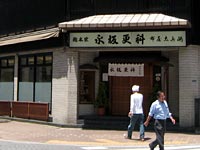
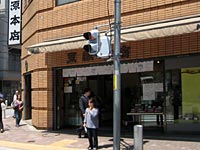
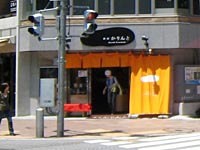

Nagasaka Sarashina (soba restaurant) was founded in the late 18th century.
Mamegen (beans tidbids shop) was founded in 1865
Azabu-Karinto (fried dough cookies shop) opened shortly.
Tatsumi (European tableware shop) was founded in 1945.
It is said that Azabu-Jūban was a very popular commercial district in the Meiji Period (1868-1912). However, the prosperity was gone after the war and in particular the dismantling of tramcar lines in the 1960s made Azabu-Jūban as if it were an isolated island. As a result, in the last decades of the previous century, Azabu-Jūban was a sort of secret haven for a limited number of well informed people who wanted to find their refuge away from the hustle and bustle of Roppongi and Akasaka.
However things have drastically changed in this century. In the year 2000 two new subway lines Nanboku Line and Ōedo Line were completedand and both lines opened a station in Azabu-Jūban. Three years later Roppongi Hills, a large scale urban development project with the 54 story Mori Tower as its centerpiece, opened right next to Azabu-Jūban. Azabu-Jūban suddenly became the most wanted residential and commercial area and changed the life in the town. Young people began gathering and living in Azabu-Jūban and new trendy restaurants and shops began opening.
I was worried whether Azabu-Jūban might change to be a faceless commercial town like thousands others. However, that is proven to be a groundless fear, at least by far. Azabu-Jūban has its resilient family business tradition and the majority of shops and restaurants are still owned and operated by families. Many newly opened shops and restaurants are also managed independently from big chains. The town is not as much overwhelmed by entertainment industry as in Roppongi and Akasaka, but high quality shops and restaurants and their loyal clients characterize the street view of Azabu-Jūban .... at least by far.
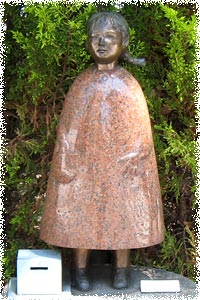
Kimichan in "Patio Jūban"
This lovely statue of a poor little girl is now the symbol of Azabu-Jūban.
In the song text she was said to leave Japan from the habor of Yokohama and there is also her statute in Yamashita Park in Yokohama.
This lovely statue of a poor little girl is now the symbol of Azabu-Jūban.
In the song text she was said to leave Japan from the habor of Yokohama and there is also her statute in Yamashita Park in Yokohama.
A poet wrote a poem on Kimi-chan on the basis of her mother's explanation and it was widely circulated in Japan with a somewhat melancholic melody in the 1920s; the title of the song is "A girl who used to wear red shoes". Though the real story might be somewhat different, the song reminds us of the poor past of Japan and the vague sentiments of Japanese people for the exotic merica.

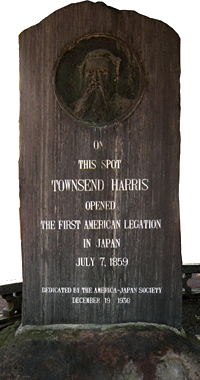

Memorial Stone for the first American legation in Japan (right)
It was originally built in 1936 and renovated in 1960. Zenpukuji-Temple seen from its approach (below)
A highrise condominium looks like a huge buddha statute, doesn't it?
Compare with the photo taken in 1861 when the American legation was located here.
It was originally built in 1936 and renovated in 1960. Zenpukuji-Temple seen from its approach (below)
A highrise condominium looks like a huge buddha statute, doesn't it?
Compare with the photo taken in 1861 when the American legation was located here.
We can find a massive stone memorial of the American legation and Tausent Harris in the court yard of Zenpukuji Temple. Unfortunately a newly built high-rise condominium destroys the view of the temple from its main entrance. The temple expresses its dissatisfaction on a flyer hanging in the court and I agree to it.
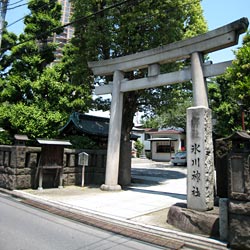 Hikawa-Jinja in Azabu |
Main street of Azabu-Jūban
